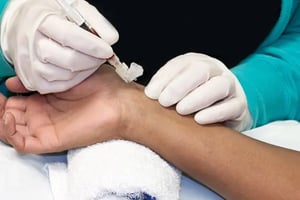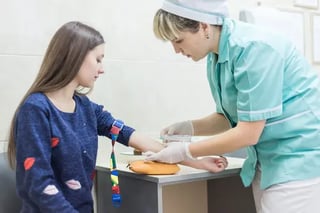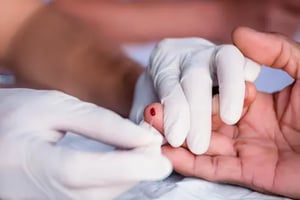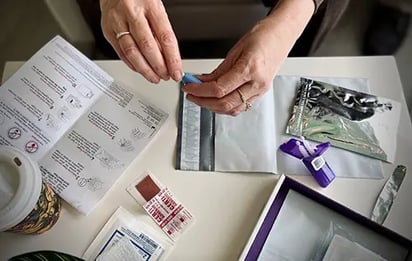Share this
collecting a blood sample: 3 methods examined
by Neoteryx Microsampling on Mar 2, 2017 6:42:00 AM

Collecting blood samples and other biological specimens is crucial to the understanding, prevention, and treatment of disease. However, from the patient’s perspective, it can also be painful, unnerving, frightening, and inconvenient.
What blood taking technique is used depends at least in part on the nature of the condition being tested for, but most commonly involves inserting a needle into a vein, referred to as a "venipuncture" blood draw. Usually, medical practitioners will draw venipuncture samples in their clinic offices or labs, at times convenient for them (if not always for patients).
What Are Some Popular Types of Sample Collection Methods Used Today?
Three popular methods of blood collection or sampling are:
Arterial Sampling
 This blood withdrawal technique most commonly takes place in a hospital environment. It is used to identify metabolic, respiratory, and mixed acid-base disorders where CO2 levels require understanding or monitoring.
This blood withdrawal technique most commonly takes place in a hospital environment. It is used to identify metabolic, respiratory, and mixed acid-base disorders where CO2 levels require understanding or monitoring.
While generally safe, the procedure can be upsetting and painful for the patient. In addition, several potential contradictions can affect the collection site, such as an abnormal modified Allen test or local infection. There is also an increased risk of bleeding complications in patients with coagulopathy.
Venipuncture Sampling
 Venipuncture is the most common way to collect blood from adult study participants or patients. Collection takes place from a superficial vein in the upper limb, generally the median cubital vein in the arm; this vein is close to the skin and does not have many large nerves positioned nearby, which reduces pain and discomfort for the patient.
Venipuncture is the most common way to collect blood from adult study participants or patients. Collection takes place from a superficial vein in the upper limb, generally the median cubital vein in the arm; this vein is close to the skin and does not have many large nerves positioned nearby, which reduces pain and discomfort for the patient.
Venipuncture can occur in a general medical practitioner’s office and is often carried out by a trained phlebotomist or nurse. However, its commonality does not equate with it being the best way to collect a blood sample. Many patients find it inconvenient and stressful. Because this approach involves collecting liquid blood in a tube, there are also risks related to the storage, transportation, and potential loss or contamination of the samples once they are collected. These same concerns also affect the suitability of arterial sampling.
Fingerstick Sampling
 Fingerstick or finger-prick sampling involves taking a minimal amount of blood from the patient, usually from the fingertip. Fingerstick sampling is over quickly and requires very little preparation, which helps to reduce stress and anxiety in patients, particularly in children and nervous adults.
Fingerstick or finger-prick sampling involves taking a minimal amount of blood from the patient, usually from the fingertip. Fingerstick sampling is over quickly and requires very little preparation, which helps to reduce stress and anxiety in patients, particularly in children and nervous adults.
Patient comfort and welfare at the point of collection is not the only reason this method should be considered the best way to collect a sample. This type of sampling takes only a few drops of blood to produce a "microsample." The long-term benefits of microsampling to the patient include the loss of less blood and the ability to carry out testing at home. Since fingerstick sampling is easy to do, a phlebotomist is not required for the procedure.
 A blood collection procedure using a finger-prick with a lancet and a portable microsampling device, such as a Mitra® device can be done by virtually anyone, anywhere.
A blood collection procedure using a finger-prick with a lancet and a portable microsampling device, such as a Mitra® device can be done by virtually anyone, anywhere.
Because finger-prick sampling can be done at home, work or in other locations, it supports a host of industry applications, like decentralized clinical trials, and remote monitoring of patients who take therapeutic drugs.
In many cases, a healthcare professional can assist with collecting the microsamples and/or provide study subjects with an initial orientation on correct self-sampling with these devices.
 Finger-stick sampling is designed to deliver a small, dried blood sample rather than a liquid (wet) blood sample. The data derived from dried samples typically correlates to the data derived from wet samples. Dried blood sampling can replace conventional sampling in many scenarios.
Finger-stick sampling is designed to deliver a small, dried blood sample rather than a liquid (wet) blood sample. The data derived from dried samples typically correlates to the data derived from wet samples. Dried blood sampling can replace conventional sampling in many scenarios.
Further, since dried blood specimens don't require cold shipping, they have the advantage of being easier and cheaper to transport to a laboratory for analysis.
Arterial and venipuncture blood withdrawal techniques are still widely used, and still have their places in medicine, clinical research, and patient care. However, with advances in technology and a greater understanding of dried blood sampling, fingerstick collection is gaining ground.
Microsampling devices from Neoteryx, the microsampling brand of Trajan Scientific and Medical, continue to advance specimen collection. These devices, which can be paired with Trajan's sample processing or sample analysis solutions, enable sample ID tracking using a barcode system. The barcoding makes any mix-up or loss of samples less likely.
Technological advances in dried sampling also mean reduced contamination risks and reduced sample rejection rates, both of which help to reduce costs.
From preclinical research to clinical trials to remote therapeutic drug monitoring, the future of microsampling is here! To learn more about how others are using microsampling in their work, visit our online Industry Applications page.

Share this
- Microsampling (206)
- Research, Remote Research (119)
- Venipuncture Alternative (105)
- Clinical Trials, Clinical Research (83)
- Mitra® Device (73)
- Therapeutic Drug Monitoring, TDM (51)
- Dried Blood Spot, DBS (39)
- Biomonitoring, Health, Wellness (30)
- Infectious Disease, Vaccines, COVID-19 (24)
- Blood Microsampling, Serology (23)
- Omics, Multi-Omics (21)
- Decentralized Clinical Trial (DCT) (20)
- Specimen Collection (18)
- Toxicology, Doping, Drug/Alcohol Monitoring, PEth (17)
- Skin Microsampling, Microbiopsy (14)
- hemaPEN® Device (13)
- Preclinical Research, Animal Studies (12)
- Pharmaceuticals, Drug Development (9)
- Harpera Device (7)
- Industry News, Microsampling News (5)
- Antibodies, MAbs (3)
- Company Press Release, Product Press Release (3)
- Environmental Toxins, Exposures (1)
- July 2025 (1)
- May 2025 (1)
- April 2025 (2)
- December 2024 (2)
- November 2024 (1)
- October 2024 (3)
- September 2024 (1)
- June 2024 (1)
- May 2024 (1)
- April 2024 (4)
- March 2024 (1)
- February 2024 (2)
- January 2024 (4)
- December 2023 (3)
- November 2023 (3)
- October 2023 (3)
- September 2023 (3)
- July 2023 (3)
- June 2023 (2)
- April 2023 (2)
- March 2023 (2)
- February 2023 (2)
- January 2023 (3)
- December 2022 (2)
- November 2022 (3)
- October 2022 (4)
- September 2022 (3)
- August 2022 (5)
- July 2022 (2)
- June 2022 (2)
- May 2022 (4)
- April 2022 (3)
- March 2022 (3)
- February 2022 (4)
- January 2022 (5)
- December 2021 (3)
- November 2021 (5)
- October 2021 (3)
- September 2021 (3)
- August 2021 (4)
- July 2021 (4)
- June 2021 (4)
- May 2021 (4)
- April 2021 (3)
- March 2021 (5)
- February 2021 (4)
- January 2021 (4)
- December 2020 (3)
- November 2020 (5)
- October 2020 (4)
- September 2020 (3)
- August 2020 (3)
- July 2020 (6)
- June 2020 (4)
- May 2020 (4)
- April 2020 (3)
- March 2020 (6)
- February 2020 (3)
- January 2020 (4)
- December 2019 (5)
- November 2019 (4)
- October 2019 (2)
- September 2019 (4)
- August 2019 (4)
- July 2019 (3)
- June 2019 (7)
- May 2019 (6)
- April 2019 (5)
- March 2019 (6)
- February 2019 (5)
- January 2019 (8)
- December 2018 (3)
- November 2018 (4)
- October 2018 (7)
- September 2018 (6)
- August 2018 (5)
- July 2018 (8)
- June 2018 (6)
- May 2018 (5)
- April 2018 (6)
- March 2018 (4)
- February 2018 (6)
- January 2018 (4)
- December 2017 (2)
- November 2017 (3)
- October 2017 (2)
- September 2017 (4)
- August 2017 (2)
- July 2017 (4)
- June 2017 (5)
- May 2017 (6)
- April 2017 (6)
- March 2017 (5)
- February 2017 (4)
- January 2017 (1)
- July 2016 (3)
- May 2016 (1)
- April 2016 (2)


Comments (11)